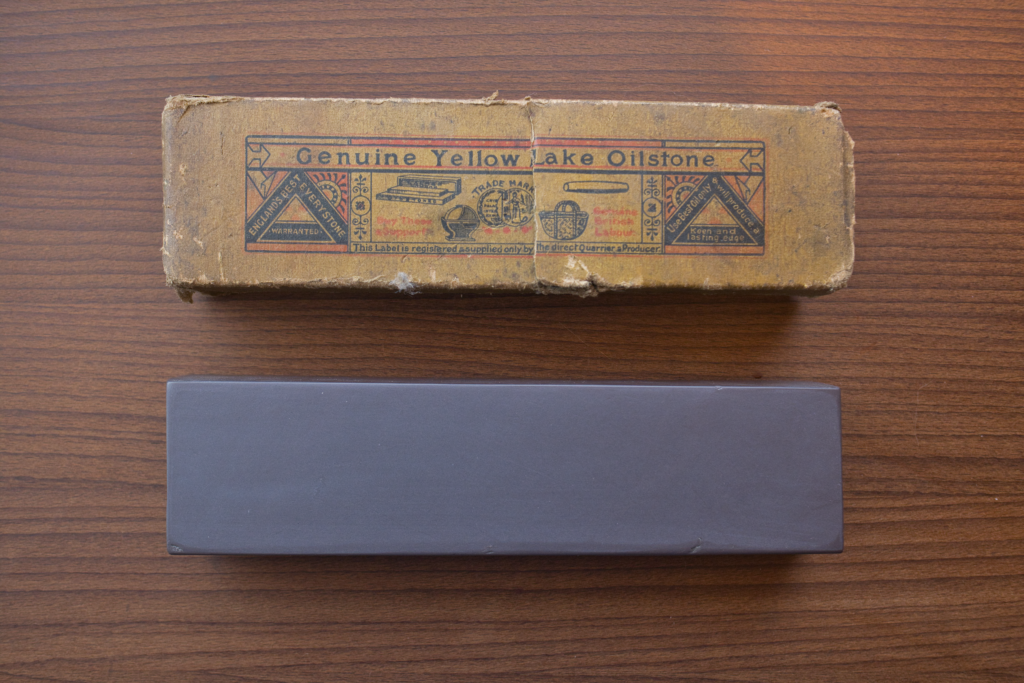The Yellow Lake Oilstone was sold by AB Salmen as a finishing hone. The stones were sourced from multiple different mines around Wales and all sold under the same Yellow Lake name. Depending on the version that you have, the performance can vary but all are competent finishing hones. The stones were most often sold in boxed format, with a Yellow Box Variety (203x51x25) and a Red Box Variety (203x51x13). The only formal difference between the box colors was the sizing. Labelled versions of the stone were also sold with labels that looked similar to the box art. Confusingly, some Llyn Idwal stones were also sold under the Yellow Lake name – but those are easy to identify as a different stone upon inspection (they will not be black, grey, or purple).
The different versions of the Yellow Lake Oilstones sold under the same name can be roughly broken down into four different groups as follows:
- The first and original Yellow Lake from a quarry at Llyn Melynllyn (Yellow Lake) which the name is derived from. This is the dark purple variety which is typically the finest variety available. They differ from other purple versions of the yellow lake by having little white lines within their structure running through them. Though most of these were sold unboxed or unlabeled, they did make up the first few runs of the boxed variety of Yellow Lake. These stones are analogous to 10-12k.
- Two varieties of Alberllefenni Welsh Slate from Alberllefenni, North Wales were also sold as Yellow Lake Oilstones after the initial supply from Llyn Melynllyn ran out. These slate stones were supplied by Inigo Jones Slateworks and came in a dark blue/grey and purple variety. These are the least fine version and most common versions of the Yellow Lake Oilstones found. Both the blue/grey and purple version tend to have tiny black dots within their structure. These dots and the lack of the white lines help to identify the difference between the original purple Llyn Melynllyn and the Inigo Jones purple stock. These stones are analogous to 8-10k.
- Inigo Jones has been producing stone since the 1800s and continues to sell a Alberllefenni slate whetstone under the name of Dragons Tongue to this day. Whether it is because Salmen did better quality control on their products or because the stock has changed as more is removed from the earth, the Dragons Tongue whetstone of today tends to be coarser than the version once sold under the Yellow Lake Oilstone name. Dragons Tongue is more firmly around the analogous 8k range.
- The last variety sold under the Yellow Lake name is actually not quite slate but a form of fine grit calcareous siltstone. These stones are dark grey in color and will be softer than other versions of the stone. Using them tends to also produce a different feel under the blade, difficult to describe but less glass-like (like most slate whetstones) and more like a Thuringian with solid feedback. Where these stones were sourced is currently unknown and they are the fairly rare (about as rare as the original Llyn Melnllyn versions) The best way to identify if you have this version of the Yellow Lake Oilstone is to put a drop of vinegar on the stone’s surface. Due to its calcareous nature, the stone will react to the vinegar and bubbles will be produced within the vinegar. If this happens, you have one of these stones. If it doesn’t, you have one of the grey Alberllefenni versions.
Specific Gravity of Yellow Lake Oilstones tends to be in the 2.65-2.75 range. They are best suited for razor work but can work well for knives with a steady hand. Yellow Lake Oilstones as the name implies works well with oil and will give the finest edge when oil is your honing medium. The stone does perform well though with water and slurry dilution method, where you finished on a burnished water only surface. The stones popularity is mostly held back by being a fairly slow cutting stone.
